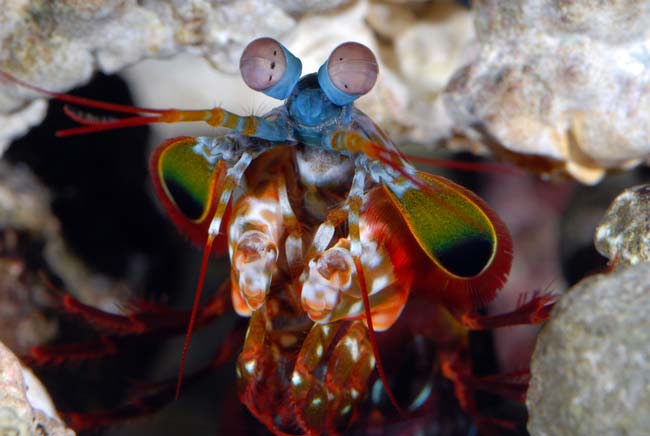Sea Creature's Amazing Eyes Could Inspire New DVD Players

Humans see three colors that, combined, allow us to enjoy the visible light spectrum. The mantis shrimp sees 12 colors, ranging into the near-ultraviolet to infrared parts of the spectrum. The creature can also distinguish different forms of polarized light.
Scientists now say this sea shrimp's remarkable eye could inspire a new generation of DVD and CD players.
Mantis shrimp found on the Great Barrier Reef in Australia and have the most complex vision systems known to science. Special light-sensitive cells rotate the plane of the oscillations, or polarization, of a light wave as it travels through it. This allows the shrimps to convert linearly polarized light to circularly polarized light and vice versa.
Manmade devices called quarter-wave plates perform this essential function in CD and DVD players and in circular polarizing filters for cameras. But these artificial devices only tend to work well for one color of light. The shrimp's eyes work almost perfectly across the whole visible spectrum, from near-ultraviolet to infrared, the researchers found.
"Our work reveals for the first time the unique design and mechanism of the quarter-wave plate in the mantis shrimp's eye," said University of Bristol researcher Nicholas Roberts, lead author of a paper on the work, published in the journal Nature Photonics. "It really is exceptional – out-performing anything we humans have so far been able to create."
Polarization vision is used by animals for sexual signaling or secret communication that avoids the attention of predators, the researchers explained in a statement. It could also help them find and catch prey by offering a clearer underwater view.
"What's particularly exciting is how beautifully simple it is," Roberts said. "This natural mechanism, comprised of cell membranes rolled into tubes, completely outperforms synthetic designs. It could help us make better optical devices in the future using liquid crystals that have been chemically engineered to mimic the properties of the cells in the mantis shrimp's eye."
Get the world’s most fascinating discoveries delivered straight to your inbox.
- 10 Profound Innovations Ahead
- Top 10 American Innovations
- All About Light



